FIAT 500X 2015 2.G Owners Manual
Manufacturer: FIAT, Model Year: 2015, Model line: 500X, Model: FIAT 500X 2015 2.GPages: 240, PDF Size: 10.72 MB
Page 171 of 240
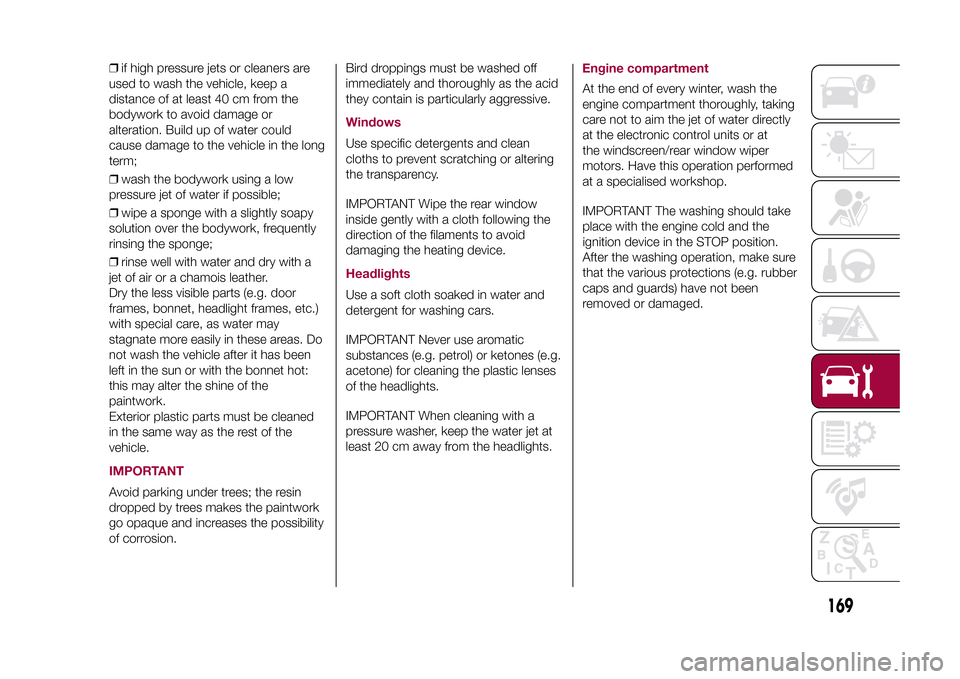
❒if high pressure jets or cleaners are
used to wash the vehicle, keep a
distance of at least 40 cm from the
bodywork to avoid damage or
alteration. Build up of water could
cause damage to the vehicle in the long
term;
❒wash the bodywork using a low
pressure jet of water if possible;
❒wipe a sponge with a slightly soapy
solution over the bodywork, frequently
rinsing the sponge;
❒rinse well with water and dry with a
jet of air or a chamois leather.
Dry the less visible parts (e.g. door
frames, bonnet, headlight frames, etc.)
with special care, as water may
stagnate more easily in these areas. Do
not wash the vehicle after it has been
left in the sun or with the bonnet hot:
this may alter the shine of the
paintwork.
Exterior plastic parts must be cleaned
in the same way as the rest of the
vehicle.IMPORTANTAvoid parking under trees; the resin
dropped by trees makes the paintwork
go opaque and increases the possibility
of corrosion.Bird droppings must be washed off
immediately and thoroughly as the acid
they contain is particularly aggressive.
WindowsUse specific detergents and clean
cloths to prevent scratching or altering
the transparency.
IMPORTANT Wipe the rear window
inside gently with a cloth following the
direction of the filaments to avoid
damaging the heating device.HeadlightsUse a soft cloth soaked in water and
detergent for washing cars.
IMPORTANT Never use aromatic
substances (e.g. petrol) or ketones (e.g.
acetone) for cleaning the plastic lenses
of the headlights.
IMPORTANT When cleaning with a
pressure washer, keep the water jet at
least 20 cm away from the headlights.
Engine compartmentAt the end of every winter, wash the
engine compartment thoroughly, taking
care not to aim the jet of water directly
at the electronic control units or at
the windscreen/rear window wiper
motors. Have this operation performed
at a specialised workshop.
IMPORTANT The washing should take
place with the engine cold and the
ignition device in the STOP position.
After the washing operation, make sure
that the various protections (e.g. rubber
caps and guards) have not been
removed or damaged.
169
15-12-2014 8:23 Pagina 169
Page 172 of 240
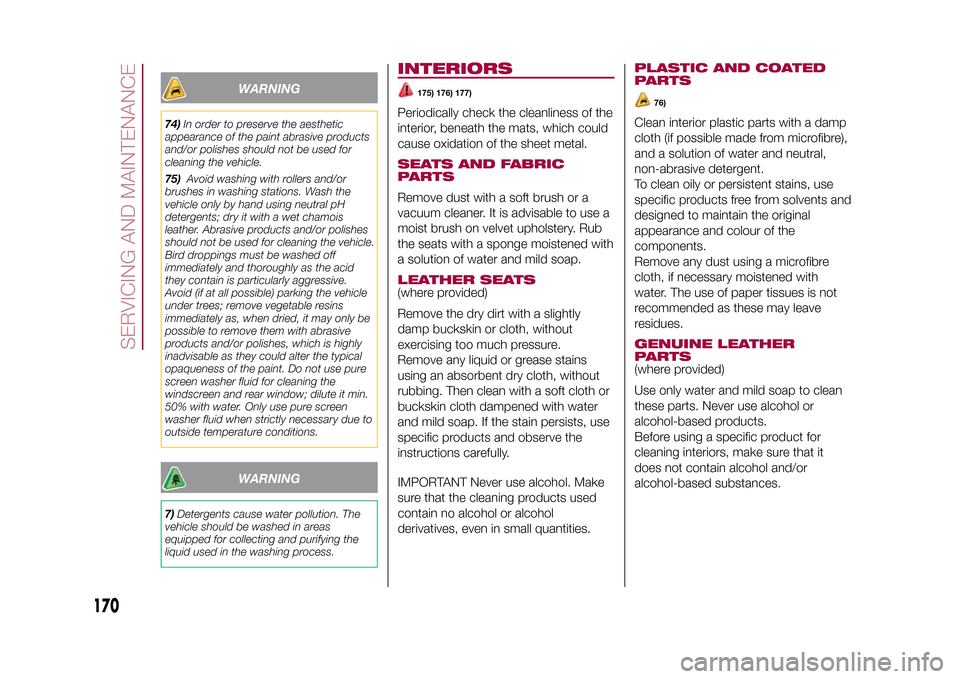
WARNING
74)In order to preserve the aesthetic
appearance of the paint abrasive products
and/or polishes should not be used for
cleaning the vehicle.
75)Avoid washing with rollers and/or
brushes in washing stations. Wash the
vehicle only by hand using neutral pH
detergents; dry it with a wet chamois
leather. Abrasive products and/or polishes
should not be used for cleaning the vehicle.
Bird droppings must be washed off
immediately and thoroughly as the acid
they contain is particularly aggressive.
Avoid (if at all possible) parking the vehicle
under trees; remove vegetable resins
immediately as, when dried, it may only be
possible to remove them with abrasive
products and/or polishes, which is highly
inadvisable as they could alter the typical
opaqueness of the paint. Do not use pure
screen washer fluid for cleaning the
windscreen and rear window; dilute it min.
50% with water. Only use pure screen
washer fluid when strictly necessary due to
outside temperature conditions.
WARNING
7)Detergents cause water pollution. The
vehicle should be washed in areas
equipped for collecting and purifying the
liquid used in the washing process.
INTERIORS
175) 176) 177)
Periodically check the cleanliness of the
interior, beneath the mats, which could
cause oxidation of the sheet metal.SEATS AND FABRIC
PARTSRemove dust with a soft brush or a
vacuum cleaner. It is advisable to use a
moist brush on velvet upholstery. Rub
the seats with a sponge moistened with
a solution of water and mild soap.LEATHER SEATS(where provided)
Remove the dry dirt with a slightly
damp buckskin or cloth, without
exercising too much pressure.
Remove any liquid or grease stains
using an absorbent dry cloth, without
rubbing. Then clean with a soft cloth or
buckskin cloth dampened with water
and mild soap. If the stain persists, use
specific products and observe the
instructions carefully.
IMPORTANT Never use alcohol. Make
sure that the cleaning products used
contain no alcohol or alcohol
derivatives, even in small quantities.
PLASTIC AND COATED
PARTS
76)
Clean interior plastic parts with a damp
cloth (if possible made from microfibre),
and a solution of water and neutral,
non-abrasive detergent.
To clean oily or persistent stains, use
specific products free from solvents and
designed to maintain the original
appearance and colour of the
components.
Remove any dust using a microfibre
cloth, if necessary moistened with
water. The use of paper tissues is not
recommended as these may leave
residues.GENUINE LEATHER
PARTS(where provided)
Use only water and mild soap to clean
these parts. Never use alcohol or
alcohol-based products.
Before using a specific product for
cleaning interiors, make sure that it
does not contain alcohol and/or
alcohol-based substances.
170
SERVICING AND MAINTENANCE
15-12-2014 8:23 Pagina 170
Page 173 of 240

WARNING
175)Never use flammable products, such
as petroleum ether or modified petrol, to
clean the inside of the vehicle. The
electrostatic charges which are generated
by rubbing during cleaning may cause a
fire.
176)Do not keep aerosol cans in the
vehicle: they might explode. Aerosol cans
must not be exposed to a temperature
exceeding 50°C. When the vehicle is
exposed to sunlight, the internal
temperature can greatly exceed this value.
177)There must be no obstacles on the
floor underneath the pedals; make sure
that mats are always flat and do not
interfere with the pedals.
WARNING
76)Never use alcohol, petrols and
derivatives to clean the dashboard and
instrument panel lens.
171
15-12-2014 8:23 Pagina 171
Page 174 of 240
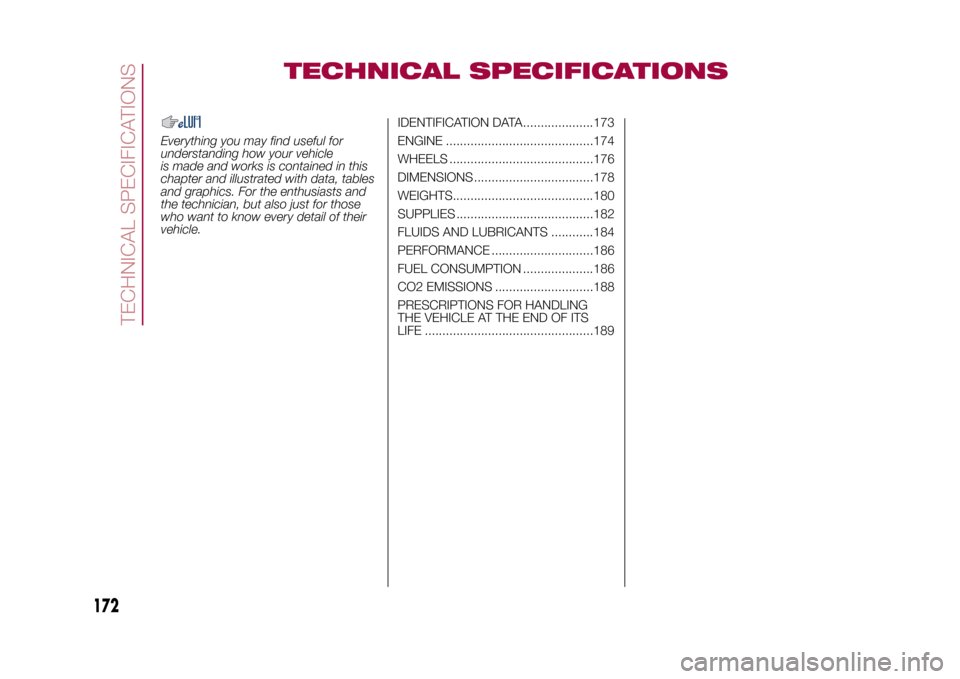
TECHNICAL SPECIFICATIONS
Everything you may find useful for
understanding how your vehicle
is made and works is contained in this
chapter and illustrated with data, tables
and graphics. For the enthusiasts and
the technician, but also just for those
who want to know every detail of their
vehicle.IDENTIFICATION DATA....................173
ENGINE ..........................................174
WHEELS .........................................176
DIMENSIONS ..................................178
WEIGHTS........................................180
SUPPLIES .......................................182
FLUIDS AND LUBRICANTS ............184
PERFORMANCE .............................186
FUEL CONSUMPTION ....................186
CO2 EMISSIONS ............................188
PRESCRIPTIONS FOR HANDLING
THE VEHICLE AT THE END OF ITS
LIFE ................................................189
172
TECHNICAL SPECIFICATIONS
15-12-2014 8:23 Pagina 172
Page 175 of 240
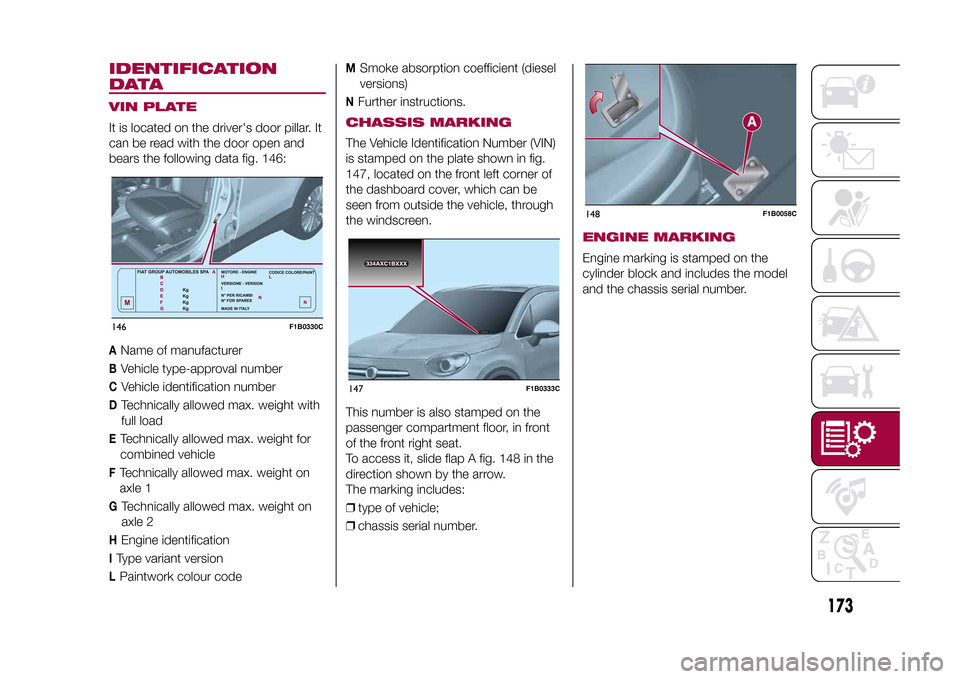
IDENTIFICATION
DATAVIN PLATEIt is located on the driver's door pillar. It
can be read with the door open and
bears the following data fig. 146:A
Name of manufacturer
B
Vehicle type-approval number
C
Vehicle identification number
D
Technically allowed max. weight with
full load
ETechnically allowed max. weight for
combined vehicleFTechnically allowed max. weight on
axle 1G
Technically allowed max. weight on
axle 2
H
Engine identification
IType variant versionLPaintwork colour code
M
Smoke absorption coefficient (diesel
versions)
N
Further instructions.
CHASSIS MARKINGThe Vehicle Identification Number (VIN)
is stamped on the plate shown in fig.
147, located on the front left corner of
the dashboard cover, which can be
seen from outside the vehicle, through
the windscreen.
This number is also stamped on the
passenger compartment floor, in front
of the front right seat.
To access it, slide flap A fig. 148 in the
direction shown by the arrow.
The marking includes:
❒type of vehicle;
❒chassis serial number.
ENGINE MARKINGEngine marking is stamped on the
cylinder block and includes the model
and the chassis serial number.
146
F1B0330C
334AXC1BXXX
334AXC1BXXX
147
F1B0333C
148
F1B0058C
173
15-12-2014 8:23 Pagina 173
Page 176 of 240
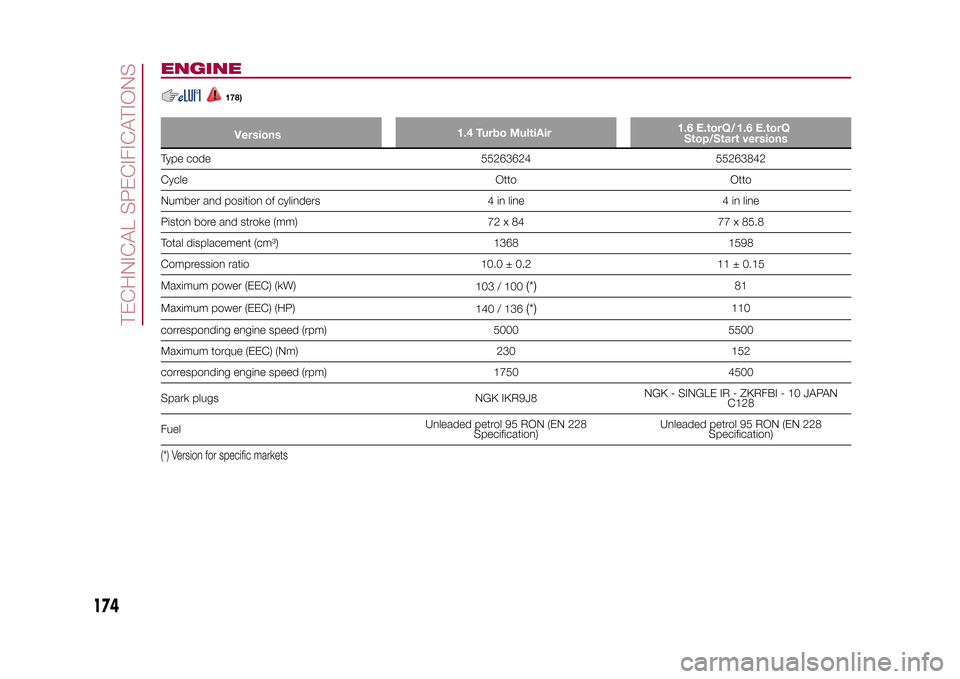
ENGINE
178)
1.4 Turbo MultiAir
Stop/Start versions
Type code 55263624 55263842
Cycle Otto Otto
Number and position of cylinders 4 in line 4 in line
Piston bore and stroke (mm) 72 x 84 77 x 85.8
Total displacement (cm³) 1368 1598
Compression ratio 10.0 ± 0.2 11 ± 0.15
Maximum power (EEC) (kW)
103 / 100
(*)
81
Maximum power (EEC) (HP)
140 / 136
(*)
110
corresponding engine speed (rpm) 5000 5500
Maximum torque (EEC) (Nm) 230 152
corresponding engine speed (rpm) 1750 4500
Spark plugs NGK IKR9J8NGK - SINGLE IR - ZKRFBI - 10 JAPAN
C128
FuelUnleaded petrol 95 RON (EN 228
Specification)Unleaded petrol 95 RON (EN 228
Specification)
(*) Version for specific markets
174
TECHNICAL SPECIFICATIONS
15-12-2014 8:23 Pagina 174
1.6 E.torQ/1.6 E.torQ
Versions
Page 177 of 240
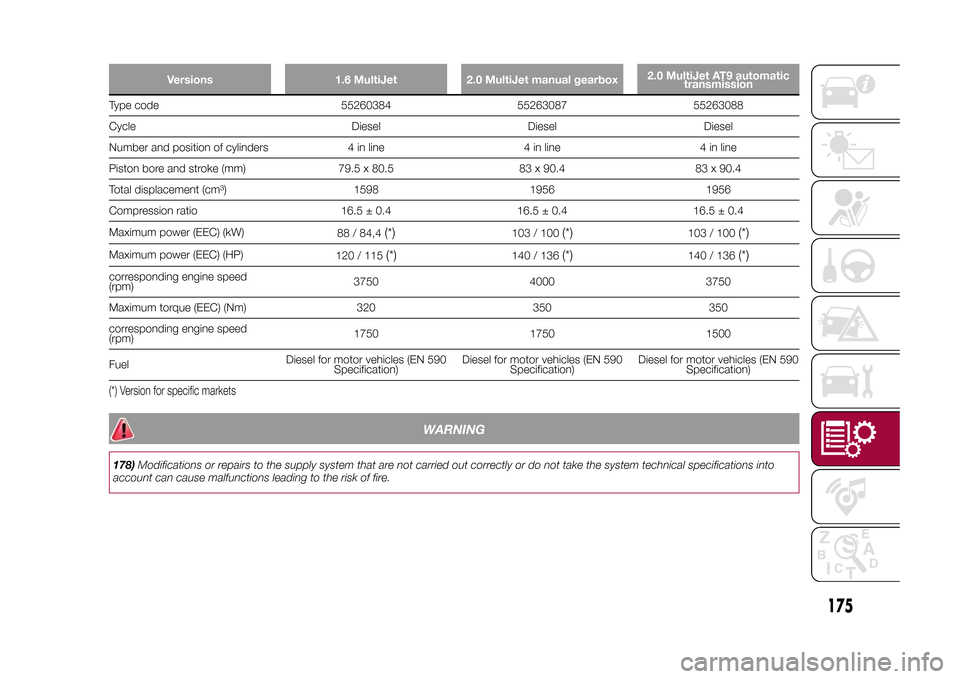
Versions 1.6 MultiJet 2.0 MultiJet manual gearbox2.0 MultiJet AT9 automatic
transmission
Type code 55260384 55263087 55263088
Cycle Diesel Diesel Diesel
Number and position of cylinders 4 in line 4 in line 4 in line
Piston bore and stroke (mm) 79.5 x 80.5 83 x 90.4 83 x 90.4
Total displacement (cm³) 1598 1956 1956
Compression ratio 16.5 ± 0.4 16.5 ± 0.4 16.5 ± 0.4
Maximum power (EEC) (kW)
88 / 84,4
(*)
103 / 100
(*)
103 / 100
(*)
Maximum power (EEC) (HP)
120 / 115
(*)
140 / 136
(*)
140 / 136
(*)
corresponding engine speed
(rpm)3750 4000 3750
Maximum torque (EEC) (Nm) 320 350 350
corresponding engine speed
(rpm)1750 1750 1500
FuelDiesel for motor vehicles (EN 590
Specification)Diesel for motor vehicles (EN 590
Specification)Diesel for motor vehicles (EN 590
Specification)(*) Version for specific markets
WARNING
178)Modifications or repairs to the supply system that are not carried out correctly or do not take the system technical specifications into
account can cause malfunctions leading to the risk of fire.
175
15-12-2014 8:23 Pagina 175
Page 178 of 240
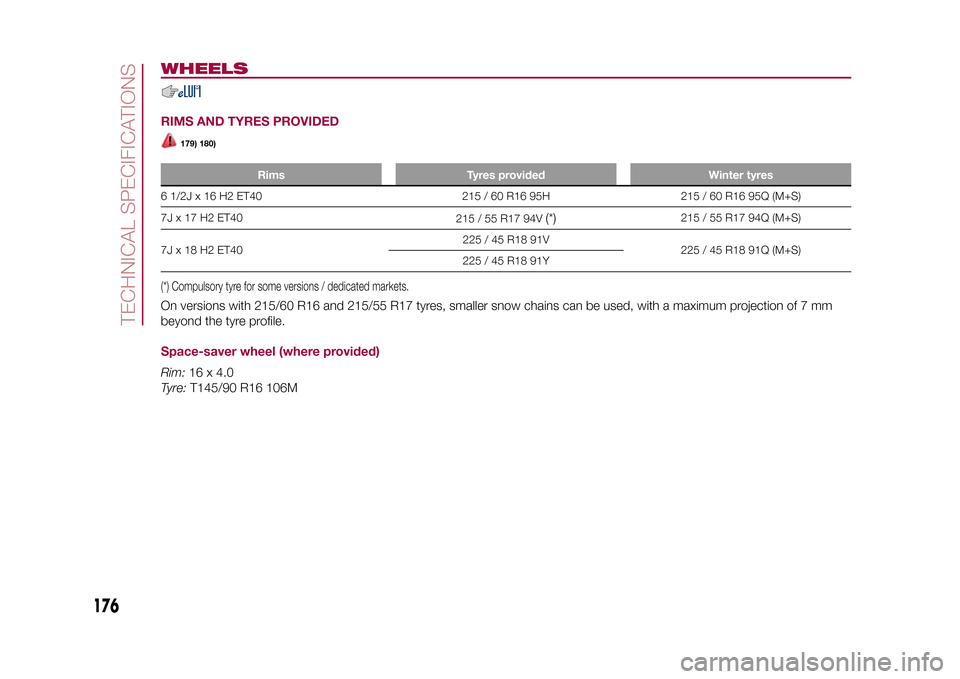
WHEELSRIMS AND TYRES PROVIDED
179) 180)
Rims Tyres provided Winter tyres
6 1/2J x 16 H2 ET40 215 / 60 R16 95H 215 / 60 R16 95Q (M+S)
7J x 17 H2 ET40
215 / 55 R17 94V
(*)
215 / 55 R17 94Q (M+S)
7J x 18 H2 ET40225 / 45 R18 91V
225 / 45 R18 91Q (M+S)
225 / 45 R18 91Y
(*) Compulsory tyre for some versions / dedicated markets.Space-saver wheel (where provided)Rim:16 x 4.0
Tyre:T145/90 R16 106M
176
TECHNICAL SPECIFICATIONS
15-12-2014 8:23 Pagina 176
On versions with 215/60 R16 and 215/55 R17 tyres, smaller snow chains can be used, with a maximum projection of 7 mm
beyond the tyre profile.
Page 179 of 240
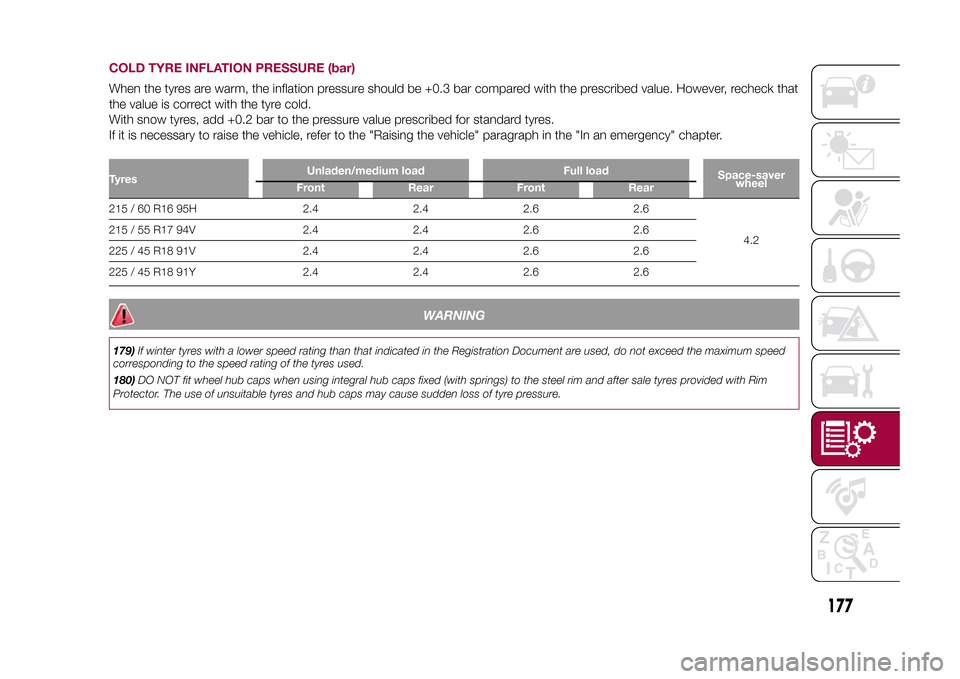
COLD TYRE INFLATION PRESSURE (bar)When the tyres are warm, the inflation pressure should be +0.3 bar compared with the prescribed value. However, recheck that
the value is correct with the tyre cold.
With snow tyres, add +0.2 bar to the pressure value prescribed for standard tyres.
If it is necessary to raise the vehicle, refer to the "Raising the vehicle" paragraph in the "In an emergency" chapter.Ty r e sUnladen/medium load Full load
Space-saver
wheel
Front Rear Front Rear215 / 60 R16 95H 2.4 2.4 2.6 2.6
4.2 215 / 55 R17 94V 2.4 2.4 2.6 2.6
225 / 45 R18 91V 2.4 2.4 2.6 2.6
225 / 45 R18 91Y 2.4 2.4 2.6 2.6
WARNING
179)If winter tyres with a lower speed rating than that indicated in the Registration Document are used, do not exceed the maximum speed
corresponding to the speed rating of the tyres used.
180)DO NOT fit wheel hub caps when using integral hub caps fixed (with springs) to the steel rim and after sale tyres provided with Rim
Protector. The use of unsuitable tyres and hub caps may cause sudden loss of tyre pressure.
177
15-12-2014 8:23 Pagina 177
Page 180 of 240
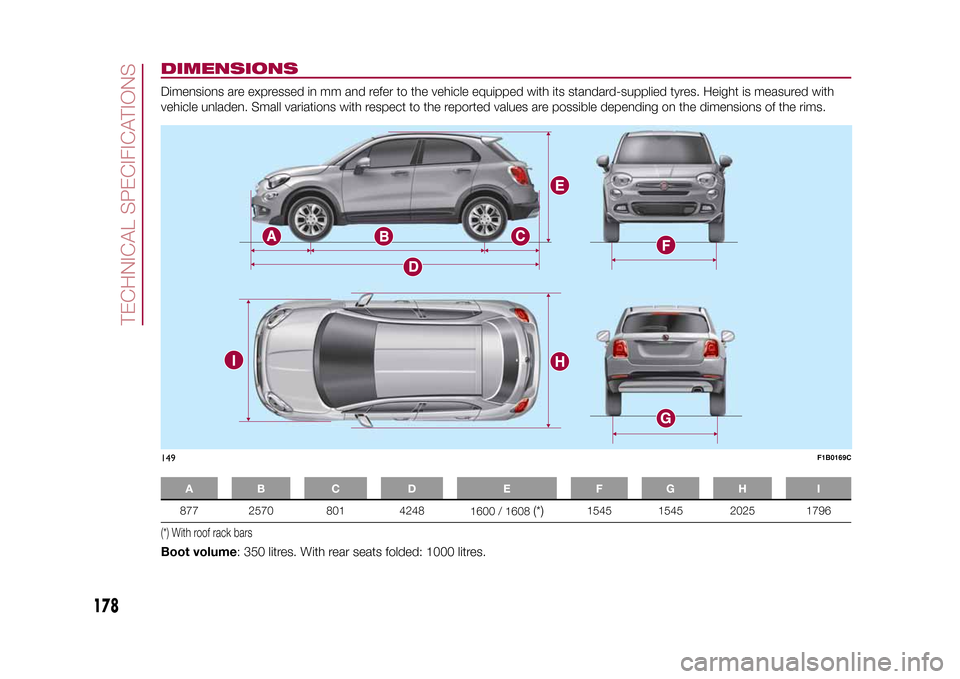
DIMENSIONSDimensions are expressed in mm and refer to the vehicle equipped with its standard-supplied tyres. Height is measured with
vehicle unladen. Small variations with respect to the reported values are possible depending on the dimensions of the rims.
AB C D E FGH I877 2570 801 4248
1600 / 1608
(*)
1545 1545 2025 1796
(*) With roof rack barsBoot volume: 350 litres. With rear seats folded: 1000 litres.149
F1B0169C
178
TECHNICAL SPECIFICATIONS
15-12-2014 8:23 Pagina 178